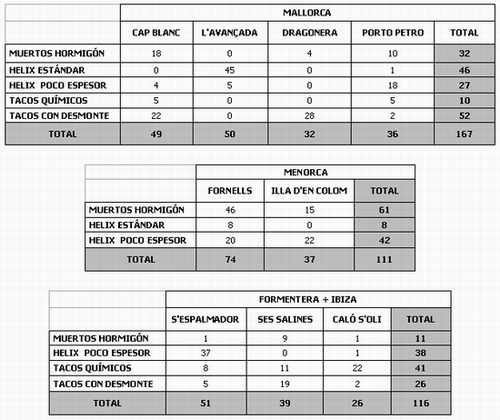Aims:
Installation of anchored buoys affixed to concrete blocks or other types
of permanent footholds, over the fields most damaged by the effects of
anchoring and which are situated in secluded coastal areas , commonly
used by yachts. The exact location of these buoy fields is defined in
Action A.3.
Implementation of the Action and present stage:
The works included in the installation contract relative to anchoring
points within SCI areas of the Balearics, stipulated the following items:
1. Checking the depth of the sandy bed situated under anchoring points by means of the use of a perfilador: This action was offered as an improvement in the contract and was considered very useful as it would make it easier to assess whether it was physically possible to install low impact footholds.
2. Revision of the calculations and tensions exerted on the anchoring points by means of a reduced-scale simulation. This action was also offered as an improvement in the contract.
3. A direct submarine prospecting study of the anchoring points. This work was previewed and included in order to check the characteristics of the terrain, where necessary. In the end it was decided to extend this work to include all anchoring points as it was considered that this type of installations require precise accuracy.
4. Actual installation of the anchoring points.
In February 2006 works for the installation of anchoring points were begun. At the same time a series of further studies, added as improvements, were undertaken in order to more fully define the characteristics of the sea floor and to improve the geometric definition of the various anchoring and foothold systems; these studies caused a certain degree of delay in the installation plan.
The installation plans for about 400 anchoring points previewed the use of one of the following systems for each point:
• Concrete block foothold: In cases where there was a sand substrate and no Posidonia.
• Ecological Screw: When upon the sea floor there was sand with a field of Posidonia growing on it.
•Chemical mass: When there was rocky ground on the sea floor, with or without Posidonia growing on it.
To carry out the works, specific information was gathered
about the make up of the sea floor and the presence of Posidonia at each
point. Applying the criteria detailed above and the technical characteristics
of the 3 systems considered produced clear definitions of the exact system
to be applied at each point and a re-counting of units.
At some installation points there was a rocky substrate covered by a very
shallow layer of sand. In these cases the most adequate solution was to
remove the sand and install the fixture of the anchoring point directly
on the rock .At some other locations for anchoring points the layer of
sand was found to be either too shallow to install the system indicated
for sand beds, or too deep to be able to remove it without damaging Posidonia
growing on it. Thus, the installed anchoring points according to type
were:

As of today (2007) it is considered that the aims of the project have been fully achieved.